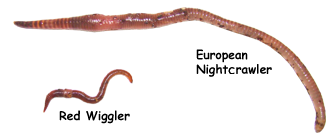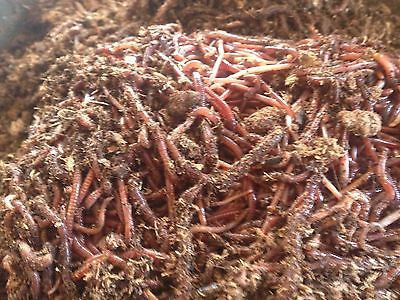Red Wiggler Worms - All-natural Solution for Environment-friendly Composting
Red Wiggler Worms - All-natural Solution for Environment-friendly Composting
Blog Article
Red Wiggler Worms Demystified: Unlocking the Tricks of Vermiculture for Greener Living and Nutrient-Rich Soil
In the realm of lasting methods for enriching dirt top quality and promoting eco-conscious living, red wiggler worms play a crucial yet often overlooked function. Red Wiggler Worms. Comprehending the intricacies of caring for these worms, optimizing their environment, and utilizing their castings can lead to a greener way of living and healthier soil for plants to prosper.
The Duty of Red Wiggler Worms
Red Wiggler worms play a vital function in composting systems by effectively breaking down organic matter into nutrient-rich spreadings. These ravenous eaters eat a variety of natural materials, such as kitchen scraps, lawn waste, and paper products. As they feed, the worms' digestive processes damage down the natural matter into a fine, dark, and nutrient-dense product called worm castings or vermicompost.
The castings created by Red Wiggler worms are extremely advantageous for soil health and plant growth. They are abundant in crucial nutrients like potassium, nitrogen, and phosphorus, which are important for sustaining healthy and balanced plant advancement. Additionally, worm spreadings contain useful microbes and enzymes that help improve dirt framework, increase water retention, and enhance nutrient uptake by plants.
Advantages of Vermicomposting

Moreover, vermicompost, the nutrient-rich end product of vermicomposting, works as an excellent organic plant food and soil conditioner. It enhances soil structure, improves dirt aeration, and increases soil wetness retention. These properties add to much healthier plants with stronger origin systems and much better resistance to parasites and diseases. Vermicompost also enriches the dirt with crucial nutrients like nitrogen, potassium, and phosphorus, advertising plant development and general dirt fertility.
Furthermore, vermicomposting assistances lasting horticulture methods by giving a chemical-free and natural alternative to synthetic plant foods. Red Wiggler Worms. This eco friendly technique not only enhances the dirt however additionally helps in reducing reliance on damaging chemicals, advertising a greener and extra sustainable method of gardening
Establishing a Worm Bin
When developing a worm container for vermicomposting, proper arrangement is crucial to ensure the success of the composting procedure. The very first action in setting up a worm container is picking an appropriate container.
After including the bed linen, present the red wiggler worms to the bin. It is suggested to start with a handful of worms and gradually increase as they increase. The worms should after that be provided with food scraps such as vegetables and fruit peels, coffee premises, and eggshells. It is necessary to stay clear of adding moved here meat, dairy, oily, or salted foods to stop bring in parasites and developing unpleasant odors.
On a regular basis keep track of the moisture degrees and temperature level in the worm container to ensure optimum conditions for the worms. With proper configuration and upkeep, the worm container will effectively transform organic waste right into nutrient-rich compost for your plants and yard.
Collecting Worm Spreadings
To effectively accumulate nutrient-rich worm castings from your vermicomposting system, an organized harvesting method is essential. When it comes time to collect the worm spreadings, there are a couple of vital actions to follow to ensure a successful procedure.

Troubleshooting Common Issues
Determining and resolving usual challenges that may emerge during the vermicomposting process is essential for maintaining a healthy and balanced and productive worm bin. One typical problem that vermicomposters encounter is overfeeding. Adding excess food scraps can cause an accumulation of dampness and acidity in the worm bin, potentially hurting the worms. To avoid this, feed the worms in moderation, guaranteeing that the food scraps are appropriately broken down before adding more. An additional issue is undesirable odors rising from the worm container. Foul smells indicate anaerobic problems, typically triggered by overwatering or inadequate ventilation. To correct this, adjust the wetness levels by adding dry bed linens products like shredded newspaper or cardboard and rise aeration by transforming the bed linen frequently.
Additionally, if the worm populace is declining or the worms show up harmful, maybe due to environmental stress factors such as severe temperature levels or pH levels. Checking these variables and making required changes is necessary for the health of the worms. By fixing these usual problems quickly, vermicomposters can ensure a smooth and successful vermicomposting process while keeping a prospering worm population.

Conclusion
In verdict, red wiggler worms play a vital role in vermiculture by damaging down organic matter into nutrient-rich dirt. Establishing up a worm container is vital for successful vermiculture, and collecting worm castings gives important garden compost for gardening.
As they feed, the worms' digestive procedures break down the organic matter right into a penalty, dark, and nutrient-dense material recognized as worm castings or vermicompost.
The spreadings generated by Red Wiggler worms are very helpful for dirt go to this website health and plant growth. Adding excess food scraps can lead to a build-up of dampness and acidity in the worm bin, potentially damaging the worms.In addition, if the worm population is declining or the worms show up harmful, it might be due to environmental stressors such as extreme temperatures or pH degrees. Establishing up a worm container is important for successful vermiculture, and gathering worm spreadings supplies useful compost for horticulture.
Report this page